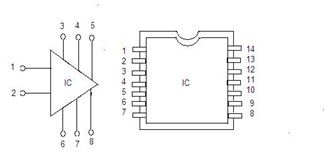Uses of Integrated Circuits
What are Integrated Circuits ?
Integrated circuits are tiny electronic circuits built to perform a particular function made of active and passive components such as transistors, field-effect transistors, diodes, resistors, capacitors, etc.
Before the invention of transistors, vacuum tubes were used. The main drawback of vacuum tubes was their size. Transistors reduced the size of circuits substantially, but still the circuits were bulky. Gordon Moore, a co-founder of Intel, had predicted that the number of transistors placed on the chip would double every two years. For every added function to circuit, the components added were almost double.
Computers, when invented, were as big as a room and very expensive. They were out of reach of common man. The complexity and the size of circuits were increasing. There was need for developing a technique which would reduce the size as well as price of the devices.
Jack Kilby at Texas Instruments invented the first Integrated circuit in 1958. Six months later, Robert Noyce fabricated an IC with interconnection on a single silicon chip. ICs are made of semiconductor chips such as silicon on which the electronic circuit is etched using the photo lithography process.
This integration has given new names to electronics as microelectronics and nanoelectronics.
Integrated Circuits

Applications and Uses of Integrated Circuits
The advantages of Integrated Circuits are:
- Very small size: Hundred times smaller than the discrete circuits.
- Lesser weight: As large number of components can be packed into a single chip, weight is reduced
- Reduced cost: The mass production technique has helped to reduce the price,
- High reliability: Due to absence of soldered connection, few interconnections and small temperature rise failure rate is low.
- Low power requirement: As the size is small power consumption is less.
- Easy replacement: In case of failure chip can easily be replaced.
Because of the above mentioned advantages IC’s found numerous applications from cars (automotive controls), televisions, computers, microwaves, portable devices like laptops, MP3, play stations, cameras, cellular phones to ship equipments, aero planes, space craft’s. These are also used in switching telephone circuits and data processing. They also found applications in military equipments. The most common application of IC is digital watch which tells hour, second, minute, day and month. Another common but important application is scientific calculator which can perform basic functions like addition, subtraction, multiplication and division as well as complex functions like square root, cube, permutations, combinations , trigonometric functions, etc
IC’s are are of Linear ,digital and mixed types. Linear IC’s also known as analog Integrated circuits are used in :
- Power amplifiers
- Small-signal amplifiers
- Operational amplifiers
- Microwave amplifiers
- RF and IF amplifiers
- Voltage comparators
- Multipliers
- Radio receivers
- Voltage regulators
Digital IC’s are mostly used in computers. They are also referred as switching circuits because their input and output voltages are limited to two levels - high and low i.e. binary. They include:
- Flip-flops
- Logic gates
- Timers
- Counters
- Multiplexers
- Calculator chips
- Memory chips
- Clock chips
- Microprocessors
- Microcontrollers
- Temperature sensors
Image credit
Microprocessor chip: https://commons.wikimedia.org/wiki/File:KL_NEC_uPD751.jpg
